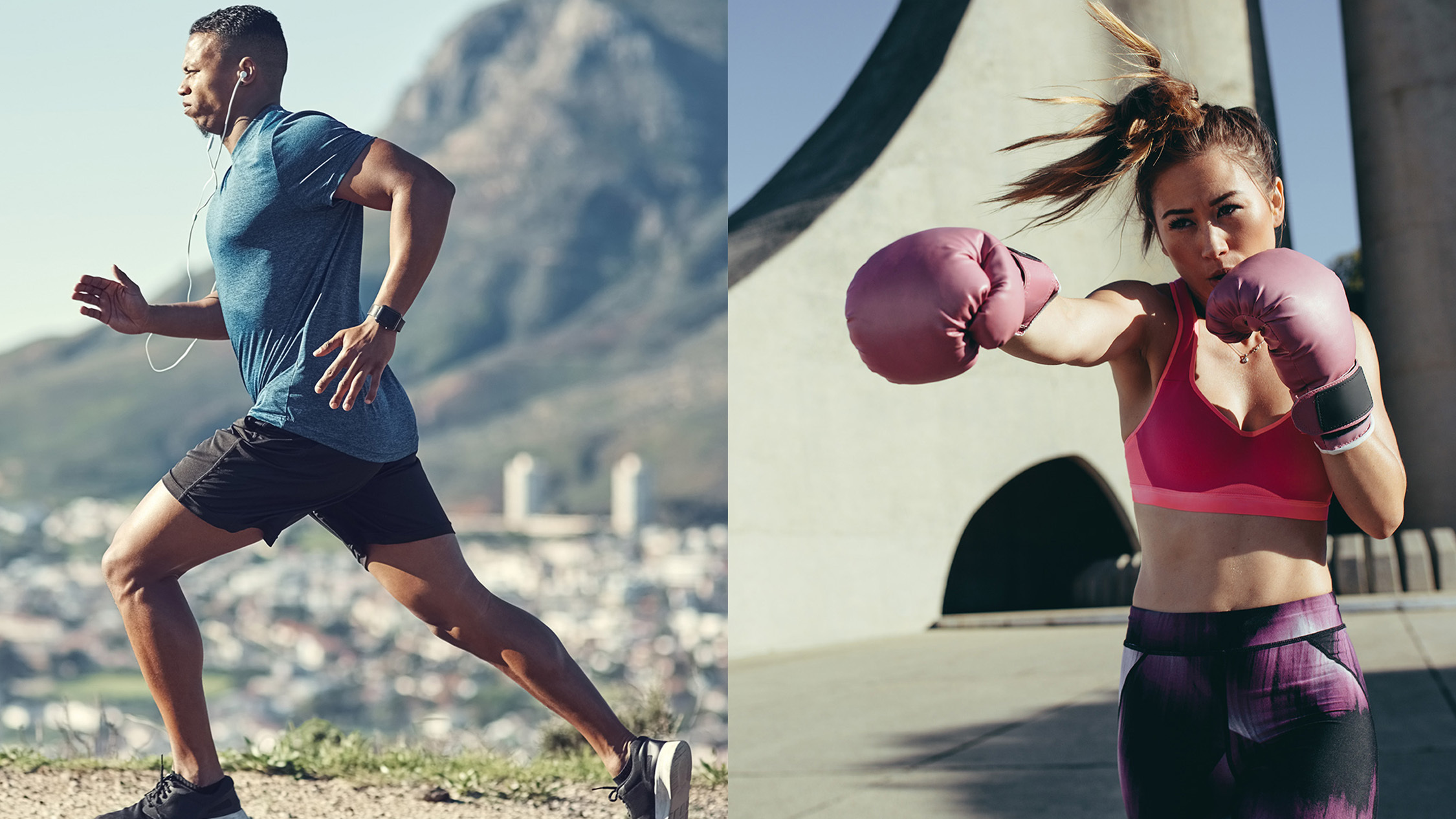
Boxing and running are popular cardiovascular sports that could improve endurance, boost your metabolism and mental wellbeing, strengthen muscles, and torch calories. And you don’t have to be an expert at either. But does one burn more calories than the other?
Boxing has stormed the charts of most popular sports and workout classes over recent years. Previously considered a professional combat sport, the benefits of boxing can now reach just about anyone. Boxing workouts are currently at over 50 billion hits under #boxingworkout on TikTok.
You don’t need to master boxing skills to rival AJ, although learning how to box safely will protect your joints when you pull on gloves to hit pads or punch bags (or a person). Even trying it could offer profound health benefits for mind and body, whether you spar or shadow box. We turned to Ben Amanna, avid boxer and founder and CEO of Boxraw, glove provider for the new Creed III film, to find out which one is a heavyweight calorie burner.
Grab the best fitness trackers, and read on.
Boxing vs running: benefits
According to Amanna, the benefits of boxing cover the mind, body, and soul and instils discipline and mindfulness. “The notion of hitting a moving object, moving your feet, and protecting yourself demands focus like no other,” he says. “Awareness of your thoughts, emotions, and surrounding environment is essential. It doesn’t matter whether you’re competing, hitting bags, pads, or shadow boxing — boxing makes you mindful.”
Amanna says you can expect to work your core, upper, and lower body and test your hand-eye coordination, footwork, flexibility, speed, and muscle power. “The intensive nature of the sport provides a total body workout that burns more calories in a shorter amount of time than any other traditional workout.” And the research seems to back it — the Strength and Conditioning Journal found that boxing is viewed as one of the most mentally and physically demanding sports in the world.
Moreover, the empowering nature of boxing teaches you to relax under pressure and keep your confidence. “You must shift a mindset of limitations to one of potential. Counter, or reposition and attack,” he says. “Boxing allows you to tune out the noise and execute in a state of flow.”

Running could develop muscle, power, and strength, depending on whether you prefer sprinting or endurance running, and it’s a potent mood booster. The exercise can strengthen your leg and core muscles, build stronger bones, improve wellbeing, and increase endurance capacity (how well your heart and lungs work).
Depending on your boxing or running style, both can tap into your aerobic or anaerobic energy systems (which we cover below), with the potential to blitz calories and boost metabolism. If you’re wondering, does running build muscle? Or how to lose weight by running, find out here.
Boxing vs running: which burns more calories?
It’s a tough one. Calorie burn depends on exercise intensity and biological factors like weight, sex, and age. And if you weigh more, you tend to burn more calories. Find out how to calculate your body fat percentage and why it matters.
Running is an umbrella term for jogging, mid-distance running, endurance running, sprinting, and anything in between, and boxing also varies in intensity. Different energy systems kick into play depending on exercise intensity. Although both are considered high-calorie burners that support weight loss, the numbers will vary depending on intensity, intervals, and workout length.
“Boxing is a high-intensity workout that engages the aerobic and anaerobic systems,” Amanna explains. “During a boxing session, the body undergoes metabolic conditioning, which involves pushing the body to its limits and challenging the cardiovascular and respiratory systems. The exact number of calories burned during a boxing session varies based on the individual's weight, fitness level, and intensity. But a rough estimate is that boxing can burn between 500-800 calories per hour.”
Post-workout (not exclusive to boxing), the body experiences the EPOC phenomenon — Excess Post-Exercise Oxygen Consumption. “This means that the body continues to burn calories at an elevated rate even after the workout has ended,” he says. “This occurs because the body needs to replenish oxygen levels, remove lactic acid build-up, and restore the body's energy reserves. It can lead to an additional calorie burn of up to 200-300 calories in the hours following a boxing session.”

According to a calorie counter that uses MET values, a person weighing 150 lb would burn around 394 calories punching bag, 558 sparring, and 916 boxing in a ring for one hour. Running is more complex and depends on distance, weight, incline, and speed. You can burn more from incline runs, further distances, increasing pace, or weighing more. But using the same metrics based on a 150 lb person running for one hour, you could burn between 358 calories hitting a 13-minute mile pace (4mph) and 787 calories at an 8.5-minute mile pace (7mph).
For context, a “good” pace is around 5-7mph, and the University of Wisconsin found the “optimum” running pace is between 8.3mph for men and 6.5mph for women. Not quite a KO for boxing, but it could just win on points.
How to burn more calories
Try uphill running, intervals, or jogging outdoors, and add bodyweight moves (like this calisthenics workout) to help your muscles work harder. For the boxers, high-intensity drills will add more resistance. You could add heavy bags or bodyweight exercises into pad work, which helps burn more calories.
Whether you prefer boxing or running, training your body to switch efficiently between the aerobic and anaerobic energy systems taps into a method called metabolic conditioning. MetCon could improve overall fitness and boost your metabolism by shifting from high to low intensity, which helps the body use energy better. Aerobic exercises use oxygen (think long steady-state runs), whereas anaerobic exercises are short-lived and don’t use oxygen — like sprinting.
If fat loss is your goal, research suggests that morning cardio workouts could encourage fat metabolism. During this time, your body may favor fat stores as an energy source!
Boxing workout for beginners
This 4-round boxing workout at home is suitable for beginners and doesn’t require equipment to prime your punches — though you could add the best ankle weights. During the rounds, you’ll tackle basic boxing punches like the jab, cross, lead hook, rear hook, lead uppercut, and rear uppercut.
More from Tom’s Guide
Sign up to get the BEST of Tom's Guide direct to your inbox.
Get instant access to breaking news, the hottest reviews, great deals and helpful tips.

Sam Hopes is a level 3 qualified trainer, level 2 reiki practitioner and senior fitness writer at Tom's Guide. She is also currently undertaking her Yoga For Athletes training course. Sam has written for various fitness brands and websites over the years and has experience across brands at Future such as Live Science, Fit&Well, Coach, and T3.
Having worked with fitness studios like F45 and Virgin Active, Sam now primarily teaches outdoor bootcamps, bodyweight, calisthenics and kettlebells. She also coaches mobility and stretching-focused classes several times a week and believes that true strength comes from a holistic approach to training your body.
Sam has completed two mixed doubles Hyrox competitions in London and the Netherlands and finished her first doubles attempt in 1:11.
